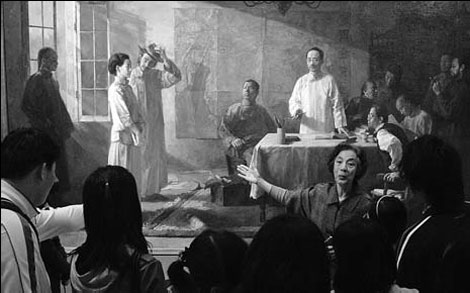Marking a century of revival
Updated: 2011-10-28 11:42
By Zhu Linyong (China Daily)
|
|||||||||||
 |
|
Visitors admire an oil painting at the National Art Museum of China. Jiang Dong / China Daily |
Chinese artists have been commemorating the 1911 Revolution with at least 10 theme-oriented art exhibitions in Beijing and other major Chinese cities in October.
The largest is entitled A Century of Revival and started with an exhibition tour at the National Art Museum of China in downtown Beijing.
Organized by the Ministry of Culture, the three-part show presents more than 300 calligraphy works, ink paintings, oil works, prints, sculptures and watercolors.
The 1911 Revolution is widely viewed as a turning point for modern China.
It overthrew the feudal Qing Dynasty (1644-1911) and, opened the gate of Chinese social development, which continues today, Chinese People's Political Consultative Conference vice-chairman Sun Jiazheng said at the exhibition's opening.
The first part of the show features original works by the forerunners of the Chinese revolution, such as Sun Yat-sen (1866-1925), Huang Xing (1874-1916), Yu Youren (1879-1964) and He Xiangning (1878-1972).
The works include original calligraphy scrolls penned by the early revolutionaries.
The most eye-catching piece is a hanging scroll written in regular script by Sun that reads Tian xia wei gong ("a nation of the people").
Sun clearly liked the phrase from the Book of Rites, a Confucian classic, and had written it on numerous scrolls which he gave to his comrades and friends, museum director Fan Di'an says.
"For these revolutionaries, calligraphy is not only an art genre but also a powerful means to convey such political ideas as democracy, liberty, and fraternity," he explains.
Also on display are works by artist-turned-revolutionaries, such as Li Tiefu (1869-1952), who played a key role in promoting oil art in the early 1900s; Gao Jianfu (1879-1951); and Chen Shuren (1884-1948). They were icons of the Lingnan Painting School of Guangdong province.
"These works are of high artistic and historical value - they offer today's viewers a glimpse of the artistic world of the early 20th century," Beijing art critic Zhu Hongzi says.
"At the same time, they demonstrate the revolutionaries' solid training in classical art and traditional disciplines."
Two other sections include award-winning artistic creations by veteran artists over the past 60 years, who have sought inspiration from the 1911 Revolution, as well as contemporary works by overseas Chinese artists, expressing their admiration for the revolutions of the last century.
To give viewers a better understanding of the 1911 Revolution, the Beijing World Art Museum has also staged a large-scale photo exhibition with a similar theme.
"This is a kind of visual history about the nation's first revolutionaries," Beijing World Art Museum director Wang Limei says, adding the exhibition is the first in a series to commemorate the historical event.
The photo show entitled Warriors of Social Justice offers 120 vintage photos, on loan from 12 museums in Hong Kong and on the mainland.
After its Beijing debut, the photo exhibition will move to Hubei, Jiangxi, Guangdong, Henan, Guizhou, Gansu and Yunnan provinces.
Funded by China Millennium Art Foundation, a picture book entitled 1911: From the Opium War to the Era of Warlords has been published to go with the exhibition.
Containing more than 400 old photos about the 1911 Revolution and its impact, the book has been compiled by Pulitzer prize-winning photographer Liu Heung Shing and will have a global release following a cooperative venture with five publishers from across the Taiwan Straits.